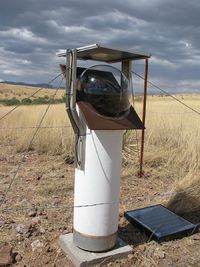Arizona Grasslands
Jump to:
Personal tools
From Time Machine
Time-Lapse of a Semi-Arid Grassland in Arizona
In semi-arid regions vegetation responds quickly to infrequent rainfall. Most of the rainfall in southern Arizona occurs during the monsoon season months of July, August, and September. This time-lapse sequence was created to capture the response of grasses, forbs, and shrubs to monsoon season rainfall.
The goals of the project were to 1) build a system, including power and weatherproof housing, for capturing images at remote sites and 2) create a time-lapse that captures the vegetative response to seasonal rainfall.
The GigaPan and a Canon G10 camera were set up in an instrumented grassland watershed in the Walnut Gulch Experimental Watershed in southern Arizona. The system is powered by a 12V battery that is charged with a solar panel. 28 pictures were taken every 2 hours. This time-lapse runs from July 11, 2011 through mid August, 2011. During this time there were 3 runoff events.
Rainfall, runoff and meteorologic data have been collected at this site since the 1950s. These data can be coupled with the collected imagery to support research to understand ecosystem dynamics. In addition to the timing of the green-up, the temporal dynamics of vegetative cover can be quantified, this is important for understanding rainfall/runoff response that is heavily influenced by cover.
Watch a time warp of a cholla cactus.
A small cholla responds to limited rainfall through the monsoon season.
The research is being conducted by Mary Nichols, Scientist, USDA-ARS Southwest Watershed Research Center, Tucson, Arizona (http://www.ars.usda.gov/main/site_main.htm?modecode=53-42-45-00).
Image capture
Imagery is captured by an Epic Pro in timelapse mode, in a weatherproof, solar-powered enclosure created by Mary Nichols.






